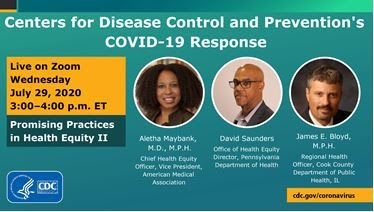

Webinar: Promising Practices in Health Equity
|
|---|
Wednesday, July 29, 2020
3:00-4:00 p.m. ET |
|---|
Join CDC’s Chief Health Equity Officer of the COVID-19 Response, Dr. Leandris Liburd, for a webinar focused on sharing promising public health practices to reduce COVID-19 related disparities. During this webinar, presenters will discuss actions taken to reduce the unequal impact of COVID-19 on racial and ethnic minorities. Additionally, speakers will take these ideas a step further and examine how they can be combined into longer-term strategies for lasting impact that will strengthen future responses and advance health equity.
Register for the webinar: https://www.zoomgov.com/
Health equity is when everyone has the opportunity to be as healthy as possible. Long-standing unequal conditions in health and social systems have put many racial and ethnic minority groups at increased risk of getting sick and dying from COVID-19.
To stop the spread of COVID-19 and move toward greater health equity, we must work together to ensure resources are available to maintain and manage physical and mental health, including easy access to information, affordable testing, and medical and mental health care.
Learn more about what communities, employers, healthcare systems, policy makers, and others can do to promote fair access to health for everyone.
Contact tracing is used by health departments to prevent the spread of infectious disease. In general, it involves identifying people who have an infectious disease (cases) and people who they came in contact with (contacts) and working with them to interrupt disease spread. This includes asking people with COVID-19 to isolate and their contacts to quarantine at home voluntarily. When more people participate in contact tracing, health departments can get a more complete picture of how to stop disease from spreading in communities.
CDC has created and compiled many resources to help local health departments in their contact tracing efforts. These include guidance documents, training resources, information on the use of digital tools, and various checklists and logs. There are even communication toolkits in English and Spanish that provide talking points, social media graphics, and PSAs. |
|---|






















.png)











No hay comentarios:
Publicar un comentario